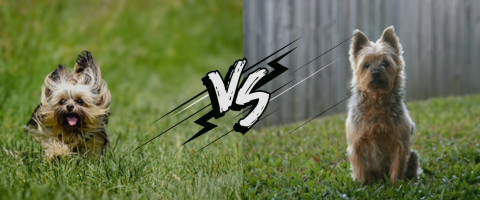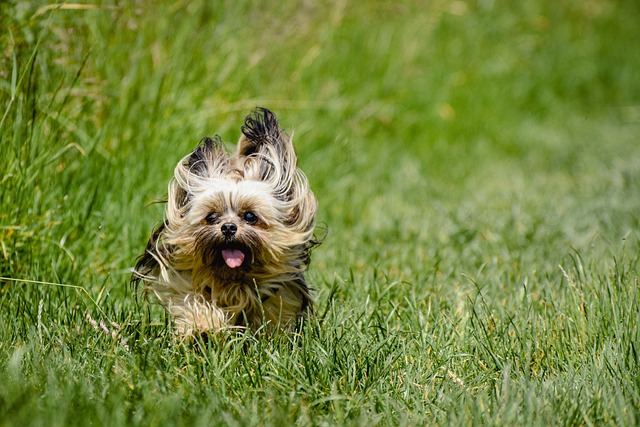
When it comes to small, energetic, and charming terrier breeds, the Silky Terrier and the Yorkshire Terrier often come to mind. Both breeds are adored for their beautiful coats and spirited personalities, but despite their similar appearances, they are distinct in many ways. Let’s dive into the differences between the Silky Terrier and the Yorkshire Terrier, exploring their origins, appearance, temperament, and care requirements.

The Yorkshire Terrier, affectionately known as the “Yorkie,” hails from England, specifically the county of Yorkshire. Developed during the 19th century, this breed was originally used to catch rats in textile mills. Over time, the Yorkie’s small size and luxurious coat made it a popular companion dog among the English elite. Its lineage includes the now-extinct Clydesdale Terrier and possibly other small terriers, such as the Skye Terrier and the Maltese.

The Silky Terrier, often called the “Silky,” has its roots in Australia. It was developed in the late 19th and early 20th centuries by crossing the Yorkshire Terrier with the Australian Terrier. The goal was to create a small, elegant dog with the refined coat of a Yorkie but the robust, lively temperament of an Australian Terrier. The Silky Terrier was initially known as the Sydney Silky, reflecting its Australian origins.
The Yorkshire Terrier is known for its petite size, typically weighing between 4 to 7 pounds. Its most distinctive feature is its long, silky coat that often reaches the floor if left untrimmed. The coat is a combination of steel blue and tan, with the blue covering the body and tail and the tan appearing on the face, chest, and legs. The Yorkie’s coat is soft and straight, requiring regular grooming to keep it looking its best.
While similar in appearance to the Yorkshire Terrier, the Silky Terrier is slightly larger, usually weighing between 8 to 10 pounds. The Silky has a longer body in proportion to its height, giving it a more elongated and streamlined appearance. Its coat is also silky but tends to be slightly shorter than that of the Yorkie. The coat color is typically blue and tan, with the blue often appearing more silver in shade. Like the Yorkie, the Silky’s coat requires regular grooming to prevent matting and tangles.
Yorkies are known for their bold and feisty personalities. Despite their small size, they have a big-dog attitude and are not afraid to assert themselves. Yorkies are loyal, affectionate, and often form strong bonds with their owners. They can be quite protective and may be wary of strangers, making them good watchdogs. However, their strong-willed nature can sometimes lead to stubbornness, especially during training.
Silky Terriers share some of the Yorkie’s spirited nature but are generally more laid-back. They are playful, intelligent, and eager to please, making them easier to train. Silkies are friendly and social dogs, often getting along well with other pets and people. They retain some of the hunting instincts of their Australian Terrier ancestors, so they enjoy chasing small animals and playing interactive games. Silkies are also known for their inquisitive and adventurous nature, always eager to explore their surroundings.
Due to their long, flowing coat, Yorkies require diligent grooming. Regular brushing is essential to prevent tangles and matting, and many owners opt for a “puppy cut” to make maintenance easier. Yorkies are prone to dental issues, so regular teeth brushing and veterinary check-ups are important. They are also sensitive to cold weather due to their small size and should be kept warm in cooler climates.
Silkies also require regular grooming, but their coat is slightly less demanding than that of the Yorkie. Weekly brushing is usually sufficient to keep their coat in good condition. Like Yorkies, Silkies are prone to dental problems, so oral hygiene is crucial. They are an active breed and enjoy daily exercise, whether it’s a walk, playtime, or a chance to run in a secure area.
Choosing between a Silky Terrier and a Yorkshire Terrier depends on your lifestyle and preferences. If you’re looking for a small dog with a big personality, a Yorkie might be the perfect fit. Their loyalty and protective nature make them excellent companions for individuals or families willing to invest time in grooming and training.
On the other hand, if you prefer a slightly larger, more easygoing dog with a playful and adventurous spirit, the Silky Terrier could be a better match. Silkies are social and adaptable, making them a great choice for families with children or other pets.
Both breeds are loving, intelligent, and beautiful in their own right. Understanding the differences between the Silky Terrier and the Yorkshire Terrier will help you make an informed decision and find the perfect furry companion to fit your home and lifestyle.
Curly tails in dogs are primarily due to genetics. The curl is usually caused by the shape of the vertebrae in the tail, which can vary among breeds. The curl provides an aesthetic trait that is often prized in certain dog breeds and is sometimes linked to the dog’s heritage and original breeding purpose.
Curly tails themselves are not typically a sign of health issues. However, in some cases, an unusually tight curl (known as a “screw tail”) can lead to skin infections or other problems if the tail is tightly wound and causes skin folds. Regular grooming and monitoring can help prevent issues.
Dogs with curly tails do not generally require special care for their tails, but it’s important to keep the tail and surrounding area clean and dry to prevent any skin problems, especially in breeds with tightly curled tails that create skin folds.
The curly tail trait can be dominant in certain breeds, meaning it is likely to be passed down to offspring if one or both parents have a curly tail. However, the exact inheritance pattern can vary depending on the breed and the specific genetics involved.
The curl of a dog’s tail is more related to the breed’s physical characteristics than their behavior or temperament. However, some breeds known for curly tails, such as the Shiba Inu or Akita, have distinct temperamental traits, like being independent or strong-willed. These behaviors are linked to their breed’s history and purpose, rather than their tail shape.
I had a great experience at Waggs to Riches!
All of the puppies are healthy and from private breeders, as the breeders information is placed on each cage. Ask the employees any questions about the puppies and they are very knowledgable, as well as attentive. If they don’t know an answer to your question about a certain puppy, they make sure to find out for you. You truly get what you pay for and if you want a healthy puppy with a creditable background, shop at Waggs To Riches. Thanks to the owner and her staff I had an amazing experience shopping here.
~ Savanah Poole